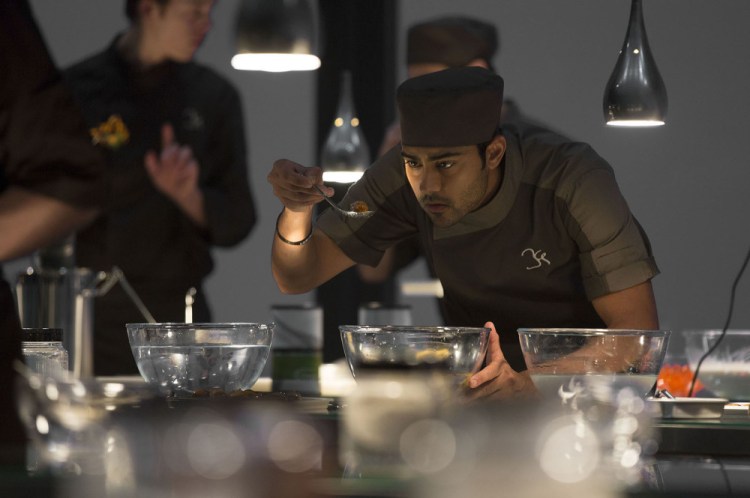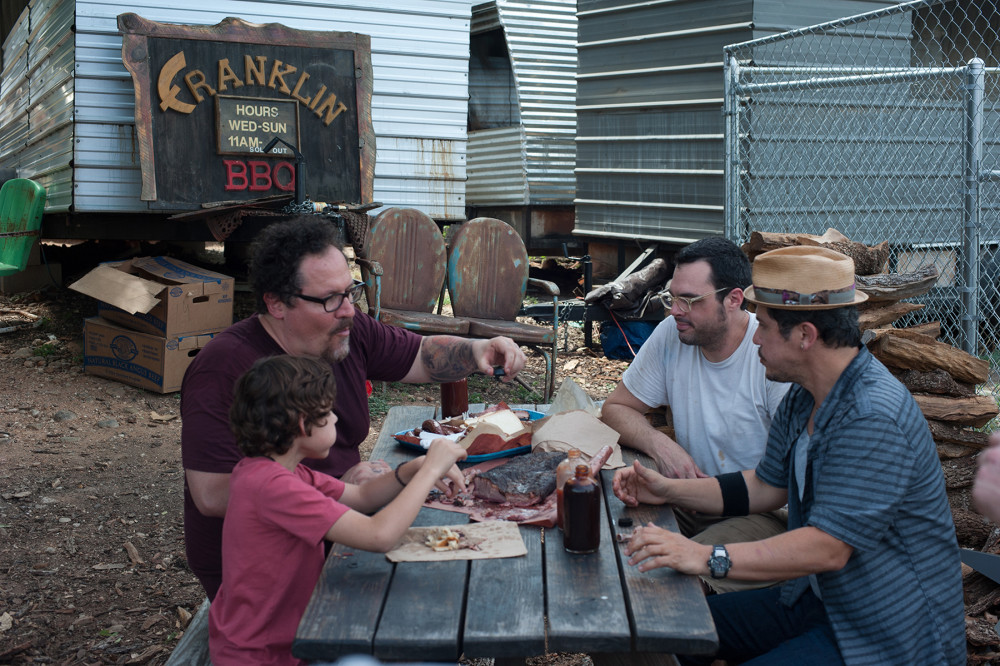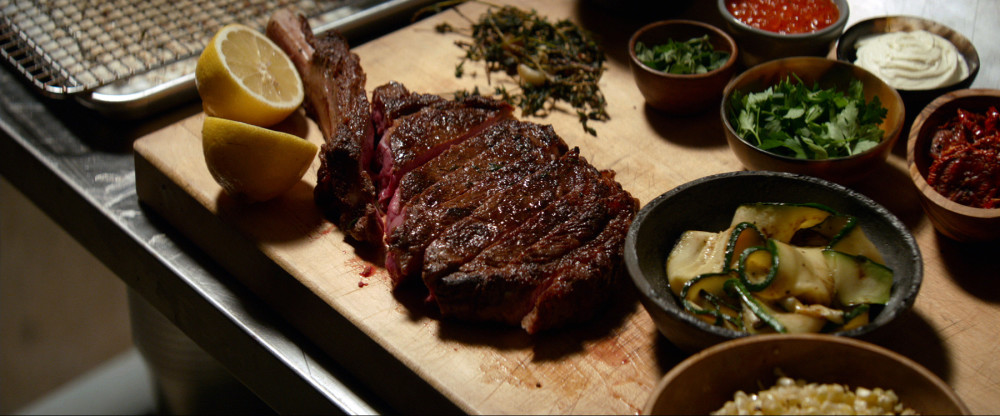The theater is dark, the film is rolling — and your mouth is watering.
Forget popcorn. This feast is for your eyes: sizzling green tomatoes, perfectly pink onions, a ripe zucchini being expertly chopped. At the helm of the knife? An actor you know and love.
Ogling food on the big screen has gotten easier and easier now that so many culinary-focused films are hitting theaters. In the past year alone we’ve seen “Haute Cuisine,” set in the kitchen of a French president; “Le Chef,” about a struggling French restaurant; “Final Recipe,” in which a boy enters a cooking contest in Shanghai to save his family restaurant; and “The Lunchbox,” about the relationship that begins when a woman’s appetizing creations are mistakenly delivered to a stranger in India.
This summer has seen two high-profile food movies: “Chef,” directed, written and starring Jon Favreau, and “The Hundred-Foot Journey” with Helen Mirren, which is now playing locally, including at The Nickelodeon in Portland and Cinemagic in Westbrook.
These aren’t just romantic comedies that happen to include chefs, a la “No Reservations” or “Spanglish.” In these films, the story lines depend on the food itself: who is cooking, what is being cooked and how the food will change the plot.
“The food is an important character itself,” said Juliet Blake, who produced “The Hundred-Foot Journey” with Oprah Winfrey and Steven Spielberg. These movies let you see the dishes come to life, from the pouring of oil into an empty pan to the first bite. Blake said Mirren put it this way: Don’t eat before the movie, but make sure you have reservations afterward.
When the camera is focused on the kitchen, director and actors can no longer expect to fake their way through the culinary arts. The growing popularity of food television shows such as “Chopped” and “Top Chef” has heightened expectations for food movies as well. The films’ creators have to make a greater effort for the kitchens and the food itself to be believable — and delectable — on screen. Even the most talented actor couldn’t pretend to chop an onion.
For Manish Dayal, that meant going off to culinary school. In “The Hundred-Foot Journey,” Dayal plays a young chef whose family has moved to southern France to start an Indian restaurant (to the dismay of a French restaurateur across the street, played by Mirren). Just as Dayal’s character eventually trains with the French greats, the producers sent the actor to a strict Paris cooking institute where he learned the basics.
Favreau took a less conventional but more intensive route by following Los Angeles chef Roy Choi for more than two months. Choi is known for his Korean taco truck, Kogi, making him the perfect fit for a movie about a chef who leaves a high-profile restaurant and finds his mojo on a food truck.
Favreau learned every part of the business, Choi said. He dined with Wolfgang Puck at the Hotel Bel-Air, but also spent hours peeling shrimp in Puck’s prep kitchen.
“Jon’s whole objective from day one was to get it right,” Choi said. “And he was a man of his word.”
Choi was heavily involved in making the kitchens in “Chef” seem realistic. Instead of building a restaurant, as did the makers of “The Hundred-Foot Journey,” Choi and Favreau filmed in the kitchen of Hatfield’s in L.A. The film’s characters also drive across the country and visit famous food establishments, including Franklin Barbecue in Austin and Cafe Du Monde in New Orleans.
Every detail of the “Chef” kitchens — the menu, the plastic mixing containers, even the folding of aprons — was chosen not for aesthetic value but to mimic reality.
“We set up the environments and cooked the food as if we were really opening a restaurant,” Choi said.
In “The Hundred-Foot Journey,” script writers made a point of incorporating real traditions of French and Indian cuisine. One of the film’s key moments is when Mirren’s character uses the making of an omelet as the litmus test of a chef’s abilities.
“Although that is an uncommon practice now, it’s what many French chefs and restaurants might have done 30 years ago,” Michel Pradier, a former executive chef at Lion d’Or in Washington D.C. who now teaches French cooking at L’Academie de Cuisine, said after a recent screening.
As each ingredient of the omelet (chervil, tarragon, parsley) is lovingly tossed into the pan, it seems almost wrong that the theater isn’t serving eggs to you, too.
The food looks so good, the producers say, because it is good. Every morsel in “The Hundred-Foot Journey” and in “Chef” is edible. Production techniques often used in advertising, such as spraying the food to make it shinier or gluing it in place, were prohibited.
Chefs, not food stylists, cooked and plated each dish, often many times over, so when a “first bite” scene needed to be filmed more than once, there would always be an untouched meal for the fork to pierce — and for the staff to eat when the scene’s filming was complete, said “The Hundred-Foot Journey” actor Om Puri.
The dishes in Puri’s film were meticulously chosen to be most appealing to American audiences. The novel that inspired movie included ingredients such as lamb’s feet, bull testicle and octopus, the last killed when its head was turned inside out.
In the movie, the Indian dishes are far more tame — and slightly geographically inaccurate. “Many of the dishes in the film are those that you would typically see in Indian restaurants in America,” Indian chef K.N. Vinod, of Indique in Washington D.C., said after the screening.
The vast majority of Indian restaurants in America serve food that would be found in northern India, Vinod said. The family in the movie, however, is supposed to be from Mumbai, in western India.
Still, dishes like chicken tandoori, saag aloo and murgh masala make for a colorful and mouthwatering introduction to Indian cuisine. Given the “Chef”‘ scenes of sugar drifting over berries, bread toasting in a grill and beef brisket releasing its juices onto a cutting board, it’s clear that the bar has been raised for what food should look like in films.
If production schedules stay on course, food-focused movies will continue taunting hungry stomachs in the foreseeable future: “Trip to Italy,” a restaurant-hopping road-trip comedy, hits theaters next week, and Bradley Cooper’s long-awaited chef film is set to open in 2015.
Some food movies, though, aren’t trying to make anybody salivate. Also out next year is “Food,” a drama about a son’s illness and a mother’s exploration of genetically modified ingredients. Doesn’t sound too appetizing, does it?
Send questions/comments to the editors.





Success. Please wait for the page to reload. If the page does not reload within 5 seconds, please refresh the page.
Enter your email and password to access comments.
Hi, to comment on stories you must . This profile is in addition to your subscription and website login.
Already have a commenting profile? .
Invalid username/password.
Please check your email to confirm and complete your registration.
Only subscribers are eligible to post comments. Please subscribe or login first for digital access. Here’s why.
Use the form below to reset your password. When you've submitted your account email, we will send an email with a reset code.